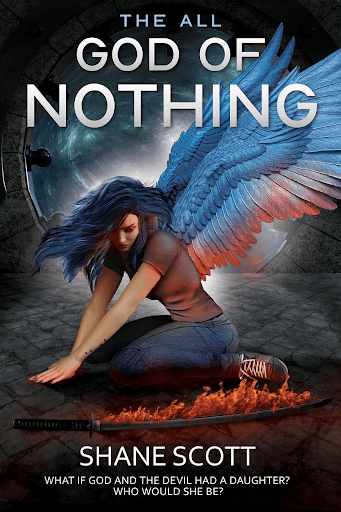Beth Tabler's Blog, page 181
June 21, 2022
#SPFBO8 Review and Cut: A Bond of Thread by Allegra Pescatore and J.P. Burnison

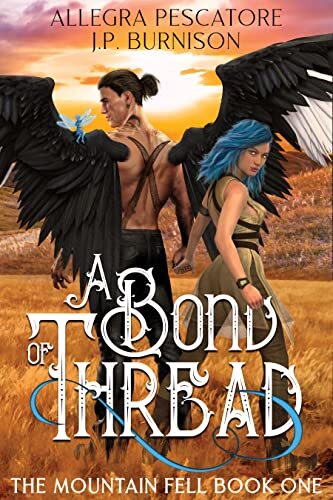
Bond of Thread is a steamy fae romance with fast-paced action and fun world-building
I snapped this book up when our group got its allotment: fantasy romance featuring fae and soul-bonding? Sign me up!
The story is fast-paced, and the enemies-to-lovers plotline is telegraphed right from the beginning, but with an interesting twist: they are soul-bonded to each other instantly, but they hate everything the other represents. Ilyas and Skye both reject the roles the world cast them into, but Fate has other plans.
This book offers an enjoyable take on some classic tropes, with excellent pacing and fun world-building. I enjoyed the diversity of fae, especially the lesser fae like the skitterlings and mosskins, who are small and quite adorable. I did wish for a bit more nuance in the world-building; it’s a high-fantasy story that doesn’t spend much time with the minutiae. Some readers will love that about it, especially those who want to tear through the fantasy plot to get at the kissy scenes, which are quite well done, but the fantasy plot didn’t grip me. The action revolves around an attack by hordes of ferals (twisted, fallen fae), who attack a village and then the cave where the lovers and remaining villagers retreat. I wasn’t invested in the struggle against the ferals, which takes up a considerable portion of the plot.
The strength of this book is the romance, which is well-developed and fun, and the writer knows how to write a steamy scene. Is it a good sign when you find yourself skimming the fantasy plot to get to the smooches? For some, the answer will inevitably be YES. Forced proximity? Only One Bed? Never Been Kissed? This book has it all, and the, erm, coming together of the hero and heroine is a delight.
Read this book if you want a steamy fae romance with a lot of action and fun world-building. This book is going to be right up some fantasy romance readers’ alley, and I urge you to give it a whirl if anything here piques your interest!
Add it on Goodreads Buy from Amazon
Check Out Some Other #spfbo8 Posts
#SPFBO8 Review and Cut – The Killer and the Dead by Roderick T. MacDonald
#SPFBO8 Review and Cut – There’s Magic between Us by Jillian Maria
The post #SPFBO8 Review and Cut: A Bond of Thread by Allegra Pescatore and J.P. Burnison appeared first on BEFOREWEGOBLOG.
SIX ELEMENTALS AUTHOR INTERVIEW – SHANE SCOTT
Six Elementals Author Interviews will introduce prospective readers to some of the best writers in their genre you may, or may not, have heard of, via a series of six questions. I encourage you to check out the work of these phenomenal creatives! Links to their websites and purchase links will always appear, accompanying the interview. Check them out!
This is a real treat for me, to be able to interview the phenomenal fantasy author, Shane Scott! Shane’s currently published works are: God of Nothing: The All; and Faith: Stories from the All.
P.L.: Such a privilege to be able to interview you, Shane! Welcome to Six Elementals Interviews! God of Nothing: The All was an incredible book, and one of the best books I read last year! What a psychedelic, absolutely wild ride through an awe-inspiring universe, both celestial and mortal. Can you tell us about what inspired you to write such an ambitious book, involving God, the Devil, demons, Bool, other gods, Titans, humans, and more?Shane: I started thinking about this story in the early 90s after a near death experience, a profound event in my life. I came away with the belief God is female, and that makes sense to me. I don’t know any man who ever gave birth to anything. As I thought about the story, I kept coming back to the concept, “What if everything we know is wrong?” That led me to create a story where everything is different from what we believe.
As well, in physics there is a quest to find a “theory of everything” math that joins Einstein’s general and special theory of relativity with quantum mechanics. Like that, I wanted a “story of everything” that combined myths, legends, conspiracy theories, God, the devil, aliens, and more. A single story that explains “everything” in a believable way. It was a lot harder than I expected.
P.L.: If there’s one part of your book that absolutely hooked me and I can’t stop thinking about, it’s “The Upstairs”! It is simply one of the coolest things I have read in recent fantasy literature!! Without giving away spoilers, can you tell the readers a little about “The Upstairs”, and how you came up with that concept?Shane: The Upstairs. Lol. I believe in balance and so after I created the Downstairs, a close comparison to biblical hell, I felt something had to exist that offset that. And since any good story has a decent bar the characters frequent, I made the Upstairs. It is still technically a part of Hell and overseen by Beelzebub and Wen, God of Chaos, however it is not punishment, it is pleasure. It is where various alien cultures (Mortals) and Immortals meet and gather and interact.
Still, being part of Hell means you have to watch your step…best time ever, if you don’t end up dead.
P.L.: Love is a big theme in your book. You represent love being able to transcend race, gender, species, and all else. You also speak to the opposite of love: hate. Can you please tell us about your thoughts on how you portray the idea of love and hate in your book?Shane: You can’t have love without hate. Again, it is a balance, an equilibrium. That does not mean it has to be a 50-50 split of the two emotions. Even if hate only accounted for one percent, it still exists and so love can exist.
Hate is powerful but it is like a nuclear bomb, it flares, causes damage, then fades and dissipates.
Love is eternal. It lasts forever. It’s not a nuclear bomb, it is springtime, soft gentle warmth from the sun, constant, like water carving the Grand Canyon.
In the short term, hate might be seen as the stronger of the two emotions but that is wrong. Love is more powerful and eventually it conquers all.
In my series, there are only two people in the All without any hate, God and one other person. I define them as “perfect.”
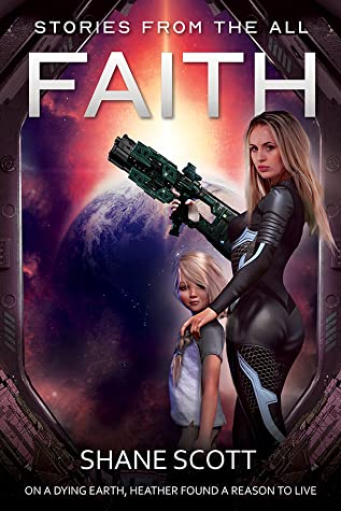
Shane: Faith is a story also set in my universe, the All. It takes place 1000 years after God of Nothing and can be read as a stand alone story. The reader does not have to have any previous knowledge of the All.
The story came about because my wife asked me for 25 years if I was planning to apocalypse the earth, and so yeah, I did.
Some of the characters from God of Nothing make cameo appearances in Faith, tying it to my All.
P.L.: What are some of the authors that have inspired you? Who are some of your favourite authors?Shane: My favorite book over the years is Armor, by John Steakley. He wrote a book where his main character, Felix has no redeeming qualities whatsoever, yet at the end, you felt like you lost a friend. I tried to make Satan, God of Hate, a little like that in my story.
I’ve also been influenced by Scalzi, Asimov, Sanderson, Robin Hobbs, Frank Herbet, and of course Tolkien. In general, I like big stories with flawed characters with mostly happy endings.
I am not a fan of the current books where at the end you feel worse than when you started reading or watching. When I finish a book I want to feel better than when I started.
P.L.: What’s next for Shane Scott? Can you please tell us a bit about the projects you are working on?Shane: I am currently working on God of Everything and hope to have it out before year end. It has most of the rest of Aja’s story and a little more Eva and Cassy.
I am also working on another novella, Belief, however I ran into some trouble. It is set in my All universe (everything I write is) and about a hybrid human-succubus and keeps trying to turn into erotica. I generally have sexual situations in my book but I fade to black before any graphic sex. I don’t think that is needed most times. When writing about a hybrid human-succubus, yeah, I think maybe some graphic sex is needed. So I am not sure where I am going with that novella.P.L.: Shane, it has been an honour to speak to you for Six Elementals Interviews! Thank you so much!
Shane: Paul, it is always a pleasure talking to you.
The interview originally appeared here.
Buy Faith: Stories from the All here: https://www.amazon.com/dp/B09RQZ2534
Buy God of Nothing: The All here – https://www.amazon.com/dp/B08W3KCRRP
https://www.goodreads.com/author/show/21598177.Shane_Scott
https://twitter.com/TheALLwriter
https://www.facebook.com/TheALLwriter
https://www.bookbub.com/profile/shane-scott

SIX ELEMENTALS INTERVIEW WITH NATANIA BARRON
Interview with Jed Herne, Author of Siege of Treboulain
The post SIX ELEMENTALS AUTHOR INTERVIEW – SHANE SCOTT appeared first on BEFOREWEGOBLOG.
June 20, 2022
Review – Black Sun by Rebecca Roanhorse
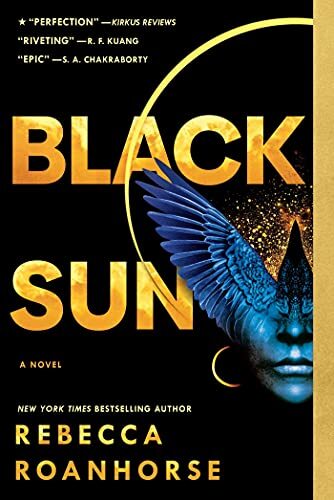 What is it About?
What is it About?The first book in the Between Earth and Sky trilogy, inspired by the civilizations of the Pre-Columbian Americas and woven into a tale of celestial prophecies, political intrigue, and forbidden magic.
A god will return
When the earth and sky converge
Under the black sun
In the holy city of Tova, the winter solstice is usually a time for celebration and renewal, but this year it coincides with a solar eclipse, a rare celestial event proscribed by the Sun Priest as an unbalancing of the world.
Meanwhile, a ship launches from a distant city bound for Tova and set to arrive on the solstice. The captain of the ship, Xiala, is a disgraced Teek whose song can calm the waters around her as easily as it can warp a man’s mind. Her ship carries one passenger. Described as harmless, the passenger, Serapio, is a young man, blind, scarred, and cloaked in destiny. As Xiala well knows, when a man is described as harmless, he usually ends up being a villain.
My ThoughtsThere’s so much to love about Black Sun by Rebecca Roanhorse. In the confines of this book, you’ll find nuanced characters, a unique setting, beautiful prose, well-written romance, strong LGBT representation, and a captivating story. Roanhorse is a prolific and highly touted author with Hugo, Locus, and Nebula awards to her name, but to my knowledge, this is her first foray into writing a high fantasy novel. Her inaugural voyage into this subgenre is a hugely successful effort—one that I’m overjoyed that I have had the opportunity to read.
Perhaps the most attention-grabbing hook to this novel is that Roanhorse eschews the conventional high fantasy setting of pseudo-medieval Europe in favor of a world inspired by pre-Columbian America. This alone makes Black Sun a breath of fresh air for longtime fantasy readers who are ready to take a step outside of the familiar. The societal structures and aesthetic that are presented in this novel make for a distinctive reading experience that transports me into an entirely different world—one that lends itself extremely well to fantasy storytelling. This strong worldbuilding is only enhanced by the implementation of epigraphs which provide in-world idioms, excerpts from documents, and other inclusions that lend a verisimilitude to the setting.
Black Sun’s worldbuilding is far from the only aspect that makes it stick out. The characters transcend familiar archetypes and each provide their own voice and perspective on the world around them colored by their own place in society and past experiences. There are four point of view (POV) characters, but the two that I found most compelling were Xiala and Serapio. Xiala is a sea-captain that belongs to a people known as the “Teek” who is living among outsiders. The Teek are an isolated society with magical powers that enable them to control the waters. For this ability, they are feared and discriminated against by those who are not a part of their society (and occasionally beloved when Teek powers serve to benefit them). Xiala’s cynical but justified perspective on the world provides her with a realistic-feeling and intriguing voice. Serapio is an individual who has been preordained to host the rebirth of a long-dead god known as the Crow God. From childhood, he must discern his role in a world where his own personal desires are so subsidiary to his inexorable destiny that his very humanity is in question. His journey through this process is fascinating. Serapio is blinded as a child within the first ten pages, so Roanhorse walks delicate ground regarding his depiction. From what I’ve gathered, she put in a tremendous amount of effort toward properly representing his experience, and though I can’t personally speak to how well she accomplished the portrayal of a blind character, I give her a lot of credit for doing her due diligence.
The two characters described above and their relationship with each other form the cornerstone of Black Sun’s reading experience for me. The remaining two POV characters are well-written, too, and in another book, I might have gravitated more toward them than I did in this one—they were just overshadowed by my two favorites. Naranpa, a figurehead known as the Sun Priest in the city of Tova, provides the reader with a perspective inside the court intrigue and complex politics taking place in her city. She comes from humble beginnings, and she must grapple with her identity, given the contrast between her upbringing and current powerful position. Meanwhile, those around her are unwilling to let her forget where she came from, and the tension throughout her chapters kept my attention and interest. Okoa, the son of a leader of the Carrion Crow Clan, is probably the character with the least depth to this point, but this seems largely attributable to the fact that he has by far the least “screen time” of any of the POV characters.
The plot is consistently engaging; although, it does seem to take a backseat to the characters in this one. One of my favorite elements about the story is that it all revolves around the ticking time bomb that is the countdown to a timepoint known as the “convergence. Each chapter begins by denoting how far away it is from the convergence. Roanhorse weaves back and forth between timepoints, which is always a potentially jarring storytelling device. I think she accomplishes this well, but there were instances where I found it disrupted the flow and had me wishing we could continue the present story. It is perhaps the pacing of the novel that I feel most critical about regarding Black Sun. The climax and conclusion arrive abruptly and seem to happen in a blink of an eye compared to the more methodical, patient pace of the beginning and middle of the book. It leaves us with a cliffhanger, and I do have a personal preference for first books in a series that tell a complete story. When a Book One in a series would also work as a standalone, it is a huge plus for me. Black Sun felt as though it might not be completely satisfying to read without intentions of continuing the story. I did feel this critique was worth noting, but it wasn’t a terrible problem for me, as I do plan on reading the recently released sequel, Fevered Star.
Overall, Black Sun by Rebecca Roanhorse is one of my favorite books that I’ve read this year.
It has so much to offer as a reading experience that transports you to another world entirely, and I’d gladly recommend to speculative fiction readers. In particular, I believe fans of NK Jemisin’s highly acclaimed Broken Earth trilogy would find this novel to be exactly their cup of tea. And I mean that to be the high praise that comes with comparing this book to a series that won a triple crown worth of Hugos. I’m excited to see more from Roanhorse, both regarding this series in particular and her continued work in speculative fiction at large.
Review – Black Sun by Rebecca Roanhorse
The post Review – Black Sun by Rebecca Roanhorse appeared first on BEFOREWEGOBLOG.
Review – DEATH RIDER – by Zamil Akhtar
Lastly, Akhtar’s prose still leaves me humming, wanting more. His “re-read passage for the beauty of it quotient” is very high.
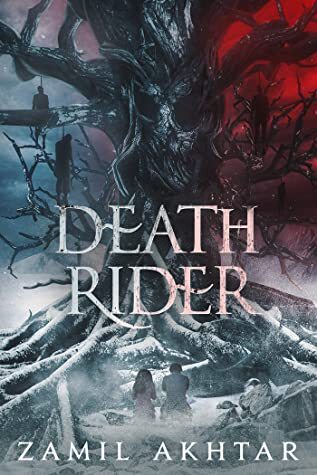 Lat, save me from Zamil Akhtar, I can’t stop reading his books!
Lat, save me from Zamil Akhtar, I can’t stop reading his books!
Here is my honest review of the novella, “Death Rider”, by Zamil Akhtar.
This book is set in the same universe as “Gunmetal Gods” and “Conqueror’s Blood”.
In “Death Rider”, we meet Darya, a disgraced Khatun (female tribal warleader), among the Sirmian tribes who is sworn to a great king, Shah Jalal, know as “The Shadow of God”. Darya’s downfall is attributed to her failure to play her role effectively in the siege of the great Crucian capital city. Due to being unable to successfully lead her troops to break through the city’s defences, the Shah sentences Darya and her compatriots to death by firing squad.
But while her other comrades are killed, the executioner assigned to Darya has his gun misfire. When he prepares to reload, the Shah intervenes, believing that it is a sign from God that Darya be spared – at least temporarily.
Instead, the Shah is determined that Darya’s death be less ignoble, and condems her to ride with the “Death Riders”, at the vanguard of the next assault on the city. The “Death Riders” are essentially cannon fodder, given inadequate weapons and armour, expendable, sure to perish in the brutality of a frontal assault on the city.
But besides the Shah, there are far greater and more capricous powers at play, perhaps, who are really the ones that have kept Darya alive, for their own ambigous, and potentially nefarious purposes.
Akhtar’s characters, at their very best, feel like they walk beside you, or at the very least that they have walked the earth in some distant alternate past, and you can read about them in some dusty history book, somewhere.
I have read few writers that have such an uncanny ability to depict the thoughts, feelings, and motivations of BOTH sides of a military conflict, with such poignancy as Akhtar. Akhtar truly makes the reader question who and what is right, and who and what is wrong. Which gods truly hold sway, and are any of them good, or truly worth of human devotion?
Darya is a fabulous protagonist. She’s formidable, a great warrior, a loving wife and mother, full of passion, duty, and a desire to protect her children and preserve her family legacy, while at the same time playing a meaningful role as a war-leader.
Her waffling between wanting to die a heroic death, and redeem her honour, versus the natural self-preservation drive, was very realistic. The secondary characters like Jalal, Niovi, and Argus are also very well drawn, and fleshed out, all the more difficult with the brevity of the narrative.
Once more, Akhtar takes us to his incredibly lush, beautiful Middle-Eastern inspired world, where life is cheap, the gods are mercurial and very fickle, and humans idle their time away in fruitless wars of conquest, while the gods laugh, and pull their puppet strings.
Akhtar’s worldbuilding, as in both of his previous novels, is some of the best you will find in Indie fantasy: layered, intricate, organically woven into the plot, so well that everything feels utterly believable. This is an especially amazing accomplishment when one can achieve such immersive worldbuilding in a novella that is less than 100 pages. I can see, when I close my eyes, the heraldric and military flags adorning the yurts, I can smell the rot of those infected by the worms, and I can hear the gunfire of the janissaries’ matchlocks.
“He smelled like the mountains of Tagkalay. LIke the caves where bright-budded pileas grew. And he was cold like the breaths that descended from the peaks. His blood was not meant to water this soil, a thousand miles from home.”
The battle scenes are intense, shocking, and amazing. Akhtar takes you into the thick of battle, and shows you it is not pretty or glamourous -it’s bloddy, messy, gross, and desperate. But there are feats of incredible heroism and sacrifice for a cause during battle that can be incredibly moving, and Akhtar truly uses the brush of a master artist to paint those scenes so vividly and so impactfully.
Fair warning, candidly I was left dazed and confused during a chapter or two in the novel, as the true nature of the cosmic horror that was controlling Darya’s fate took shape, and everything became a blurry kaleidoscope of mobius loops, zombies controlled by leeching worms, and shocking revelations. You as the reader may lose your balance for a moment as well.
Moreover, as with all of Akhtar’s works to-date, this book is very violent, dark, and disturbing. Some of the images may haunt you, for a very long time.
Still, the momentary disorientation is worth the payoff, and you will finish the novel feeling a bit stunned, and not quite sure of everything that happened, yet completely amazed by the author’s talent.
Lastly, Akhtar’s prose still leaves me humming, wanting more. His “re-read passage for the beauty of it quotient” is very high.
“He handed us mushrooms for the pain we hadn’t sstarted feeling. Or rather for the death fear a reider ought not to feel when charging the enemy. As I bit down on the supple flesh of he mushroom, I realized what it was: an invitation for the mind and sould to go first, before the body followed.”
“Death Rider” is bewildering, glorious, spectacular, exceptionally well-written, and a wonderful book.
Zamil Akhtar is one of my favourite authors, and my only advice to the reader is just keep reading everything he writes: you won’t be disappointed. Five stars for “Death Rider”!Read Death RiderSIX ELEMENTALS AUTHOR INTERVIEW – ZAMIL AKHTARReview – Gunmetal Gods by Zamil AkhtarThe post Review – DEATH RIDER – by Zamil Akhtar appeared first on BEFOREWEGOBLOG.
#SPFBO8 Review and Cut – A Deadly Bloom by Kody Boye
 Bryce’s people live on the backs of these giant tortoises…
Bryce’s people live on the backs of these giant tortoises…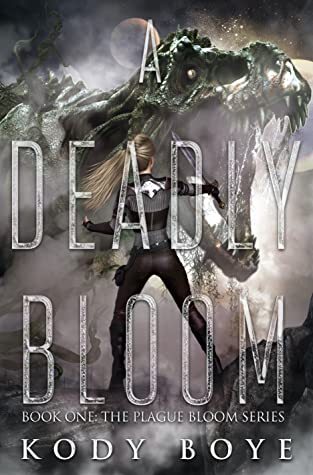 What It’s About
What It’s AboutMy name is Bryce Song, and for my entire life, I have lived in the shadow of a deadly Bloom that not only kills, but raises the dead. Since the plague’s beginning, my people have journeyed toward our God’s Promised Lands atop the backs of the Guardians. I have always wondered if we would reach our destination and felt helpless against the seemingly insurmountable odds.
A great valley, filled with its Fallen peoples and their undead protector, separates us from our salvation. The only chance of killing our monstrous enemy is to find a weapon, once wielded by our God. During the long journey, our heroes have been slain, and few are willing to embark on a quest to retrieve the holy relic.
There’s no question what I must do. I must journey to the last resting place of our God, and reclaim the weapon that will save my people from certain destruction.
My Thoughts
Before #SPFBO8 started I’d decided to go into the first round without reading the book blurbs. I really wanted to treat this round as the slush pile read that Mark Lawrence describes on his blog. So given that, I started A Deadly Bloom by Kody Boye guessing at it’s content based on the title and cover alone. I figured, “must be something about plague spores with very large monsters.” I wasn’t far off on that initial assessment though it took until about the 25% mark to determine where the story was going and flesh out what the blurb above indicates.
A Deadly Bloom is a zombie book. This isn’t a major reveal, I mean it tells you in the blurb (if you read it) and you figure it out very quickly within the opening pages. I mention this now because some people hate zombie tales while others love them. Personally I kind of like them, there’s something to that relentless drive zombies have, the mystery of their origin, and the struggle against overwhelming odds for the protagonists. So, within the first few pages I was thinking to myself, “this could be cool, let’s see where it goes.”
The mood of the book in its early stages is somber and dark. This is very fitting given events that happen from page one. That mood shifts ever so slightly after the first 10% or so but it’s still there in the background. What I liked about the way Boye set this up is that it really allowed you to get into the head of Bryce, the story’s protagonist and narrator. Bryce is a teenager who now has to grow up quick and on her own, and she’s feeling some things.
As I noted above, Bryce is the narrator and she’s telling her story in the first person present. This is a bold choice as most book length stories are not told in the present, and they tend to stand out to a reader. At first this really bugged me. Something about it was just not working for me, like it utilized mostly telling and felt wooden. After a while I found I didn’t notice it as much, but it still stood out. I’m not sure if I was just getting used to it, or if something changed subtly with the style that I didn’t pick up on.
It’s not until the 25% mark that we get a sense of where the book is really going. In story time this is only about two or three days into the plot. So on one hand, within the narrative timeline things are moving quickly, but within the pages things seemed to progress slowly. I was hoping to get a sense of the overall plot direction a little quicker. But this will hit other readers differently.
What really caused me to pause however were story elements that kept pulling me out of the read. Some of this was minor, like one description of the people’s burial ground as having fertile soil, but then following that up by stating nothing at all ever grows there. Very trivial I know, but I couldn’t stop saying to myself the soil doesn’t seem very fertile then. But some of this seemed more integral to the plot and world building. A little background…Bryce’s people live on the backs of these giant tortoises (I mean super big turtles with legs hundreds of feet long and shells three thousand feet wide) who are walking every so slowly across this narrow strip of land with water on both sides. They have been walking for twenty years since the plague started, trying to reach the promised land at the edge of the world. Nobody knows if or when they’ll reach this promised land but they are patient. There are also elves who live inside giant flying whales who every so often interact with the humans on the tortoises. One day the elves come to visit and they say they’ve seen the promised land and it isn’t far off. This is good news, but when asked how they’ve seen it they respond with what sounds like common sense…since they fly high up in the sky they can see way over the horizon, further than what the turtle dwellers can see. But immediately I asked myself if they can fly around faster than the turtles, and see for much greater distances, why did it take 20 years to finally see the promised land when they are traveling in a straight narrow path? Maybe the world is super huge, but it just really was a bit much for my suspension of disbelief.
It was around this point I decided to dnf and cut this book. It does have elements I like and that I think others will too (zombies, apocalyptic plague vibes, dark tone), but there were too many things pulling me out of the narrative, and I felt it was progressing a little slowly for my taste. I stopped at the 28% mark on my kindle.
Read A Deadly Bloom#SPFBO8 Review and Cut -; Empire Under a Dying Sun by Joseph O. Doran
The post #SPFBO8 Review and Cut – A Deadly Bloom by Kody Boye appeared first on BEFOREWEGOBLOG.
June 19, 2022
Review – LIGHT GIVER by Mike Slade
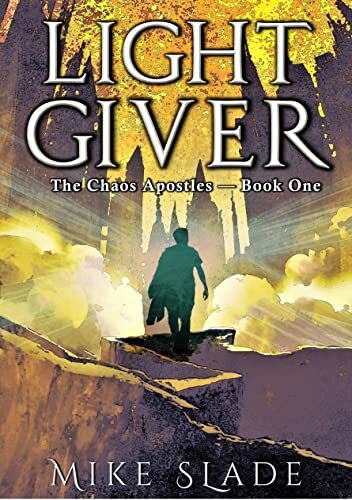 The theme of my May 2022 reading was #DebutFantasy, and among the excellent debut books I read was “Light Giver”, a new epic fantasy by Mike Slade.
The theme of my May 2022 reading was #DebutFantasy, and among the excellent debut books I read was “Light Giver”, a new epic fantasy by Mike Slade.
The story is focused around teenagers Kaine and Na’Serra. Kaine, through circumstances beyond his control, is forced to separate from his father, abandon his home, and seek the wardship of his uncle. Kaine also discovers he is imbued with magical healing powers. Events continue forward, and Kaine is compelled to travel to Na’Serra’s realm, where the two young people meet. Na’Serra also has magical gifts, that she must learn to harness.
Both teens must ally, and embark on a quest to fully realize their magical powers, and save humankind, though all the while Na’Serra is hunted by a sinister anti-magic group. The teens will be hard pressed to overcome any differences between them, trust each other, and survive.
For me, every novel’s enjoyment lies for the most part in character development. While I did crave even more appraisal of the main characters, overall I was quite satisfied with what we learned from Slade about those characters in terms of their viewpoints, motivations, and ideals.
Slade’s two protagonists in “Light Giver” hail from diametrically opposed classes and standards of living. This makes for some interesting reading, as the two characters learn about each other and bond over the course of the book.
Na’Serra is a princess, while Kaine’s origins appear more downtrodden. This difference in class sometimes brings the two main players into opposition with one another, as they strive to see each other’s unique perspectives.
What unites the two is their age – replete with all the teenage angst, growing pains, and discomfiture – and their burgeoning powers that they struggle to understand and control. These two were excellent characters, very well-drawn by Slade, who the reader will no doubt root for. Both protagonists mature and evolve as the book progresses, as they face numerous dangers and challenges.
Slade also gives the reader a religious fanatic as the primary antagonist, and any one who has read my reviews knows that this is precisely the kind of baddie that I find wholly fascinating. To balance this, we meet the guardian of Na’Serra, named Deondoria, who becomes the moral conscience of the story, and helps guides the young novices through many trials and tribulations, as they begin to fulfill their destiny.
Books without depth in terms of issues being addressed tend not to engage me as much as those who tackle sensitive topics. I was happy to find that Slade took on some difficult subject matter in the book, and handled that subject matter with aplomb.
Slade probes some compelling themes in “Light Giver”, such as mental health, identity, adherence to one’s religion while avoiding religious intolerance, monotheism, cultural sensitivity, open-mindedness and enlightenment. Much of these themes are explored through Kaine’s arc, and throughout the book Kaine is confronted in terms of his ability to examine his beliefs and adapt his thinking.
The worldbuilding and magic system were also strong points to this book. Particularly the power to heal and rune casting I found very interesting, although Slade teases the reader, keeping the full extent of such powers, it would seem, for later installments in the series. Slade is deliberate in his creation of various cultures, faiths, and customs within his world, and how the differences between people impact the story.
This is a gripping novel, and for all Slade’s excellent character work, the book is well-paced.
Give me a well-written, character-driven book with compelling themes, and you will have my attention. There is a lot more to “Light Giver” than those two elements aforementioned, and because of the sum of it’s parts, “Light Giver” is a 4.50 out of 5, and Mike Slade has put me on notice that he is an author to watch. I’m looking forward the next book in the “Chaos Apostles” series.
Read Light GiverReview – THE SHIPS OF MERIOR by Janny Wurts
The post Review – LIGHT GIVER by Mike Slade appeared first on BEFOREWEGOBLOG.
June 18, 2022
Review – THE SHIPS OF MERIOR by Janny Wurts
I will read every single book that Wurts has ever written or will write in the future
“On the morning the Fellowship sorcerer who had crowned the King at Ostermere fared northward on the old disused road, the five years of peace precariously re-established since the carnage that followed the Mistwraith’s defeat as yet showed no sign of breaking.”
And so continues one of the most highly lauded epic high fantasy series, and for me the second book in the greatest fantasy series, EVER. That book, entitled “The Ships of Merior”, takes the readers of seminal author Janny Wurts back to the incredible world she has created, first seen in “The Curse of the Mistwraith”, volume one in “The Wars of Light and Shadow.”
I read this book for my #March of the Sequels TBR a few months ago, but I am still thinking about it, and it has taken me so long to get my thoughts down on paper, so impactful was this book on me. Nevertheless, here we go.
 THE SHIPS OF MERIOR PLOT SYNOPSIS
THE SHIPS OF MERIOR PLOT SYNOPSISApproximately five years have passed since the events of “Curse of the Mistwraith”. Following the catastrophic events at the conclusion of that book, and the massive battle that left ruinous consequences, especially for Arithon’s side, said Arithon, known as the Master of Shadow, has gone to ground.
Arithon is plagued by guilt, and determined to protect his scattered and wounded allies and sworn vassals from further harm. But he needs all the friends he can get, with the magical powers normally at his disposal seemingly curtailed. Thus, despite not wishing more lives to be lost, being embroiled in Arithon’s wars, it seems inevitable that Arithon’s allies will continue to pay a heavy price for their allegiance, with their master appearing more vulnerable than ever before.
The erstwhile Prince Arithon is living under an assumed name, travelling with the kind and aging Master Bard, Halliron. Since Arithon is a peerless musician himself, and a worthy heir to Halliron’s legacy, there is a level of contentment in Arithon’s vocation, but he is still traumatized by his war with his half-brother, Prince Lysaer, and determined to avoid conflict with Lysaer at all costs. His solution: avoid Lysaer, period.
But Lysaer is obsessed with tracking down and killing Arithon. Using all his charm and charisma, and drawing all his allies to his cause, the determined Prince amasses large forces, bent on locating his foe, and destroying him. With his faithful second-in-command, Lord Diegan, at his side, Lysaer is still driven by the Mistwraith’s curse (as is Arithon) to eternal enmity towards Arithon, and will exact horrible punishment on any who stand in his way of his mission to eliminate his half-brother – in Lysaer’s mind, to make the realms free of the ultimate threat of the evil Master of Shadow.
Meanwhile, both the Fellowship Sorcerers and the Koriani Enchantresses have their own plans for both Princes, and are working overtly or surreptitiously to influence the outcome of the conflict, since the Princes hold the fate of the world in their hands.
CHARACTERSWurts’ characterization continues to be masterclass.
Arithon and Lysaer still take centre stage in this second book of the series, but there is some definite scene-stealing from several characters, including Dakar the Mad Prophet, Jieret, Mayor Captain Pesquil, Dhirken, and Jinesse who all really shine through as characters of note. Dakar in particular is maddeningly wicked, selfish, obtuse, even downright evil, but also extremely funny, with much of the humour in the book coming at the Mad Prophet’s expense.
As in the previous book, every character, especially the main ones in Arithon and Lysear, do terrible things. They also do noble things. Their CHOICES make it difficult, at many junctures, to label them either good or evil, based on those choices.
Every character is so complex, so filled with conflicting motivations and desires, and Wurts does a phenomenal job of making you feel sorry for these morally grey characters one minute, detesting them the next, cheering for them, then cheering against them, then devastated if they don’t make it through the book. Additionally, and brilliantly, Wurts juxtaposes sets of characters against each other, to the point where the reader will start to question what truly constitutes good versus evil.
PACINGWhat I am finding now, in reading my third Janny Wurts novel, is that, of all her startling writing skills, she truly knows how to stick a landing. The climaxes of her novels are fantastic. The build-up always makes the pinnacle worth it, and the pinnacle itself is always explosive and leaves the reader reeling.
Yes, the novel is a slow burn, punctuated with some incredibly poignant and gripping scenes throughout. But you will not want to skip anything, because when the truly thrilling parts of the novel arrive, all the beautiful, more quiet, reflective scenes, the political maneuvering, the romance, the touching parts that will leave you sad, all leading up to the big battles will be far more appreciated, for how they tie into the ending.
WORLD-BUILDINGI stated in my review of “Curse of the Mistwraith ”, that Wurts’ worldbuilding rivals all the great fantasy writers who are renowned for their worldbuilding. Since “The Ships of Merior” takes us to even more unique lands, and introduces us to ever more unique people and customs than the previous novel, nothing I have read in the second book does anything to change my initial assessment.
There is a lush ancient history, backstory, lore, a variety of current and defunct kingdoms, ethnicities, races (including centaurs!) and cultures, and complex mythologies clans, magical guilds, complex royal genealogy, prophecy that transcends millennia, unique languages, complex magic systems and mysticism.
Wurts’ imagination, skill, and depth of research taken to create such an intricate and complex place, featuring a splinter world, main core world, and more, is staggering.
Of note, is that Wurts should receive far more attention for her fight scenes. They are amazing, poetic, intense, brutal, glorious. Wurts also does a fabulous and very realistic job of depicting huge military campaigns, what it takes to supply the armies, how the armies move, obstacles to massive troop movement, terrain and supply-line issues, scouting challenges, and everything involved with larger scale warfare, including naval warfare. Whether at land, at sea, or both, Wurts can really write a thrilling battle sequence.
Finally, the musical performance by Halliron (and Medlir) in Jaelot, is one of the most consequential scenes I have ever read in fantasy. I read that scene at least three times, before I could move forward with the rest of the book. Read this scene, and be completely amazed not merely for the beauty of the writing and the emotional effect the scene will have on you as a reader. Be also amazed for a hint of the larger implications that Arithon’s power could have on the world, and who or what is lurking beyond the fringes of reality, ready to return to a world where their presence has not been seen for countless years.
THEMESIt would be extremely oversimplifying “Ships of Merior”, and indeed the entire “Wars of Light and Shadow Series”, to say that it is about a war between good versus evil, as evidenced by the two brothers, each representing a side. It would be oversimplifying to say that the novel is about pathos, because of Wurts’ incredible ability to make the reader feel sorry for both brothers (and those caught up in their war), completely manipulated by the Mistwraith’s curse, in hatred of one another. What I find the main theme of the novel to be, oddly enough, though in so many ways because due to the curse, the brothers are robbed of their choices, is about that very thing: choice.
So many of our characters have to make decisions in the novel, under duress, under a curse, under influence of their leaders, or in a moment of crisis. But ultimately, they are still the characters’ choices, largely of free will, to be good or bad, to administer justice blindly, or give miscalled mercy, to sacrifice themselves, or sacrifice others, to keep their oaths, or to forsake them, no matter the personal cost, even their very lives. I found it fascinating to witness what the characters did with their choices, and amazed – often horrified – even when those choices were made for altruistic, or entirely pragmatic reasons, at how devastating the consequences could be for others.
Yet overall, the primary secondary theme I have found running through the book, more prominent than in the previous installment in the series, was the concept that evil can be subtly cloaked (to a degree where it actually seems like “goodness”) in a veneer of kindness, civility, and outward beauty, while goodness can appear crude, uncultured, “ugly”.
I do need to take a moment to speak of romance, as well, in the book. There is more of that in this book than in “The Curse of the Mistwraith”, as we see Lysaer and his right hand man Lord Diegan’s sister Lady Talith’s courtship escalate, while the forbidden passion between Arithon and Elaira comes to a head.
I am a lover of romance, and have read a lot of pure romance books. Still, some of the most heartbreaking passages I have ever read in that regard, ones that truly hit me in all the feels, came in of all things, a fantasy novel: this novel, as opposed to a romance novel. Those passages were centered around Arithon and Elaira.
“What Elaira felt for this man was real, untarnished. Yet she could not wrench hope back into her hands, nor cross the gulf, nor complete the desire between them. Not without sullying forever the shining truth of her love, that Morriel’s manipulation had no part of.”
All I can say is the four or five pages preceding that passage and the paragraphs following it were completely heart-wrenching to read, in all the right ways.
PROSEPerhaps since Shakespeare, never have I read prose that beguiles me in the way the Wurts’ prose does.
Yes, THAT is how luxuriously Wurts writes. But to be clear, I am someone who loves relishing and basking in the beauty of language, and quite happy to take my time in doing so. If that’s not for you – in other words if you prefer scarcity of words, just to get through the book, under no circumstances do you wish to stop and savour every single word, candidly: look elsewhere.I give you a sample of the type of marvellous, melodious prose one can expect from Wurts:
“The change came with such masterful subtlety, Meldir alone could name the moment when senseless strings of syllables strung together for their resonance and rhythm. Against the superlative weave of the lyrante, the counterplay of consonant and vowel sparked like gems of a tapestry. The heart leaped in step for pure wonder.”
Yet, even if you are that type of reader that desires less flowery prose, I still encourage you to give this book, and all Wurts’ books, a chance. There is an obvious elegance and utter sophistication to Wurts’ writing, but the dichotomy is there is also an efficiency and simplicity that, the more you read of the author, the more straightforward and simple, in a weird way, the writing seems. It is resplendent writing that is also very functional. It is layered, it is meant to be read carefully and not rushed over, but it is also very effective, and very very beautiful. And, if you continue reading, you may find that it suits you just fine.
CONCLUSIONThis has been a long review, as I attempted to do justice to the sheer brilliance of the author, who has blessed fantasy readers with yet another chapter in what in my mind is one of the best fantasy series EVER. Still, I feel wholly inadequate in trying to review “The Ships of Merior”, and my praise of this book seems paltry, compared to how I actually feel about it.
I can tell, now that I have read the first two books in the series, Wurts is just teasing the reader, with the ramifications of some of the decisions and events that took place in “The Ships of Merior”, in terms of what consequence they will have on the overall series.
Only two books in, as a reader, I am aware (intuitively, from what long-time readers, and from what the author herself notes about it) that I truly don’t know so much of what is REALLY going on yet in this series. There is a lot more to “The War of Light and Shadow” than immediately meets the eye, or that one can discern this early on in the series.
But as my eyes are slowly opened, the scope of what Wurts has accomplished becomes more and more startling and magnificent. Yet, as the veil is being pulled back, novel by novel, in an eleven-book saga, I am more determined than ever to focus on enjoying the ride, and being content to have all things revealed to me, in good time, rather than trying to solve all the mysteries at once. I suggest if you read this book, to consider doing the same, to enhance the pleasure of your reading experience.The combination of the lusciousness of Wurts’ writing, the enormity of the depth and breadth of the worldbuilding, the immaculately drawn characters, and the poignancy of the themes make the Wars of Light and Shadow series like nothing else I have ever read, and the books that I will no doubt return to time and time again to re-read them, for pure reading joy.
I will read every single book that Wurts has ever written or will write in the future. Simply put, she is my favourite author of all-time. That is on a list of my favourite authors that includes such luminaries as Jemisin, Gwynne, Tolkien, Abercrombie, Lawrence, Cameron, Cornwell, and T.H. White.
I am enriched as a reader for experiencing “The Ships of Merior”, and will be counting the days until I can read the next installment, “Warhost of Vastmark”.
Read The Ships of Merior and the Next Books in the SeriesSix Elementals Interview – Janny WurtsThe post Review – THE SHIPS OF MERIOR by Janny Wurts appeared first on BEFOREWEGOBLOG.
#Bookcook The Pan-Galactic Gargle Blaster and Smash a Gold Brick Into Your Face
According to The Guide, this is the best drink in existence.
Its effects are similar to “having your brains smashed in by a slice of lemon wrapped around a large gold brick.”
According to fan lore and the website Hitchhikers Fandom the ingredients are as follows:

Image by Melzzeny
Mixing Instructions
Take the juice from one bottle of Ol’ Janx Spirit.
Pour into it one measure of water from the seas of Santraginus V — Oh, that Santraginean seawater! Oh, those Santraginean fish!
Allow three cubes of Arcturan Mega-gin to melt into the mixture (it must be properly iced or the benzene is lost).
Allow four liters of Fallian marsh gas to bubble through it, in memory of all those happy Hikers who have died of pleasure in the Marshes of Fallia.
Over the back of a silver spoon float a measure of Qualactin Hypermint extract, redolent of all the heady odors of the dark Qualactin Zones, subtle, sweet and mystic.
Drop in the tooth of an Algolian Suntiger. Watch it dissolve, spreading the fires of the Algolian Suns deep into the heart of the drink.
Sprinkle Zamphuor.
Add an olive.
Drink… but… very carefully…

makemeacocktail.com
I checked the pantry and it seems I am out of Fallian Marsh Gas. However, I have read a little research about a similar recipe of easy-to-find ingredients at this end of the backwaters galaxy. According to Geekychef.com, one can make a similar approximation of the “gold brick smashing into the head effect” with a few substitutes.
Ingredients
1 part Everclear (or any other strong grain alcohol such as Bourbon, Moonshine, or Vodka)
1 part Bitter Lemon (or plain Tonic Water)
1 part Bombay Sapphire Gin (or other gin)
1 part Yukon Jack Perma-Frost Schnapps (or other mint schnapps, or white crème de menthe)
Enough blue food coloring to make the mixture a very light sky blue
Sugar cubes
Cinnamon extract
Yellow food coloring (optional)
Angostura Bitters
Olives
Directions
“Mix the first five ingredients and chill. Then, take a sugar cube and let it absorb 1 milliliter of cinnamon extract and 1 drop of yellow food coloring (optional). Place three ice cubes in a glass and pour the chilled liquid mixture over these. Drop in the sugar cube and stir to dissolve, or just let it sit (if food coloring is used, often the sugar cube is just left to sit, to create a layering effect with the color). Sprinkle the Angostura Bitters in the drink, and add an olive. Drink, but very carefully. Geekychef.com “
#Bookcook A.D New Orleans After the Deluge by Josh Neufeld
The post #Bookcook The Pan-Galactic Gargle Blaster and Smash a Gold Brick Into Your Face appeared first on BEFOREWEGOBLOG.
Review – Of Honey and Wildfires by Sarah Chorn
the real star of the book is how Chorn expresses both the joy and sadness so innate in the human condition
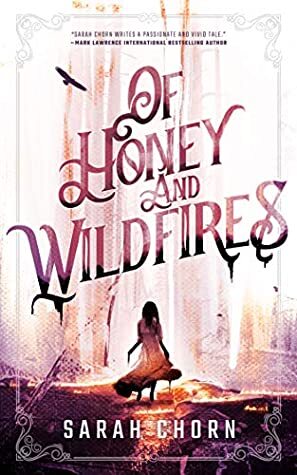 I’m not a big fan of poetry.
I’m not a big fan of poetry.
Not that I think poetry’s bad – of course not. Poetry just doesn’t speak to me in the way that it speaks to others. The beautiful abstraction of feelings into artfully chosen metaphors never really works for me, though I can see the appeal. Maybe it’s because I’m some sort of a soulless golem who can only communicate through blunt language and jokes.
But I digress.
I’m not a big fan of poetry, but Sarah Chorn’s Of Honey and Wildfires is poetry manifest in a form that makes sense to me. Chorn’s lush prose paints the harrowing, emotional tale of a family rent apart by tragedy, grief, and love. While the weird west world of Wildfires is certainly a beautiful one – that of a 18th-century style American frontier on the cusp of industrialization through the use of a miracle alchemical oil called ‘shine’ – the real star of the book is how Chorn expresses both the joy and sadness so innate in the human condition. Chorn uses words and phrases that can transform from gorgeous lyricism to daggers and stones in the space of an instant. I’m not big on emotions, but if I was, this book would have made me feel them.
Of Honey and Wildfires is cut from the very same sort of cloth as Krystle Matar’s Legacy of The Brightwash (though Wildfires far predates it), but is a much quicker read, though no less emotionally devastating. So if you enjoy deep dives into the very crevices of the human soul with the trappings of light fantasy, make sure Sarah Chorn’s Of Honey and Wildfires is on your list – not to mention the two sequels. You won’t regret it.
Read Of Honey and WildfiresReview – Of Honey and Wildfires by Sarah Chorn
The post Review – Of Honey and Wildfires by Sarah Chorn appeared first on BEFOREWEGOBLOG.
June 17, 2022
Plantasy
What makes speculative fiction speculative? Of course there are creatures like dragons and space whales, races like elves and Klingons, and fantastical powers, be they technological or magical in origin. But none of these things could function without the plants that are the basis for life as we know it. And what better way to world-build a science fiction or fantasy universe than creating wild and wonderful plants and trees to populate it, or use real-life plants in intriguing ways?
In this post I will spotlight some of the most interesting plants from a variety of SFF books, both published and coming soon! Grab an herbal tea and settle in to learn about the fantastical flora that bring the magic to these tales.

1.The Dark Heart of Redemptionby Darran Handshaw
Darran M Handshaw writes sci-fi fantasy adventures in the ruins of a high-tech city with a main character who is a cross between MacGyver and Archimedes!
The Dark Heart of Redemption: With the Pyramid under siege and a deadly new threat that might destroy all of Redemption, it is up to the Engineer and the new Princess of Raedelle to unite the dominions in a battle that will determine whether civilization lives or dies!
This standalone sequel to The Engineer is coming soon!
The image to the left was created by Vladimir Rikowski.
The plant: Ardianteki, the Homeroot of the Kainai, and waythorn
The Homeroot is a massive tree in the Underforest that the Children live inside. Waythorn is a plant that has paralytic qualities and is used to coat blades in order to render enemies immobile without killing them.
Snippet:
They were led to a tree that, at first, Actaeon thought was a cluster of trees, so wide was its base. Its grayish-brown form towered above them – the branches a city for birds that stretched to the heavens. The bird sounds coming from above were a cacophony that made it difficult to hear.
The trunk was supported by roots that fanned out to the sides like great arches of a castle. Many of the roots originated above the ground so that beneath the tree was a maze of openings and tunnels. It was a massive one of these openings that they were led inside. It made Actaeon feel quite small. The Kainai guides led the way deep into the loam of the earth, down winding passages of moss and rock and root.
As the dim light of the Underforest faded, Actaeon realized that he could still see because of the light emanating from clusters of glowing green, phosphorescent mushrooms that grew in recesses along the passage they travelled. The intervals of the natural light sources were conveniently distributed such that Actaeon imagined they must’ve been grown purposely in those locations. The path finally opened to a tremendous room that was brightly lit by thousands upon thousands of the tiny glowing mushrooms. The majority of them grew from above, their roots clinging to the wood of a massive hollow in the tree’s trunk.
Most of the mushrooms glowed green, but there was a scattering of purple and blue phosphorescence as well. Actaeon quickly recognized that the purple and blue mushrooms were arranged in familiar patterns. He had seen them often on various artifacts around Redemption – symbols in the language of the Ancients that weren’t fully understood. “This place is fascinating,” he whispered.
Buy the other books in the series from Amazon
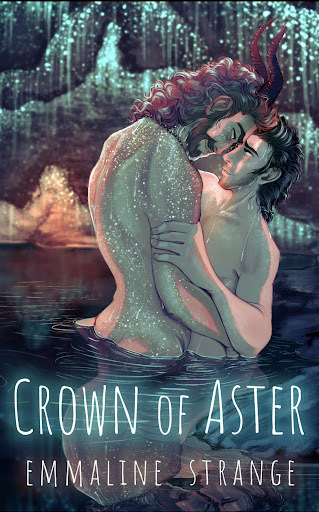
2.Crown of Asterby Emmaline Strange
Emmaline Strange writes queer fantasy & paranormal romance with cheeky tropes and boys just STUPID with love.
Crown of Aster: Immortal faun himbo sees nerdy neurotic disaster bi and thinks, “Huh! That’s a whole ass husband.”
Cover art by BEAR PETTIGREW AKA @CROSSROADART everyone should follow them and become obsessed with them!! The cover image is from a scene in the book with some smooch content in Adair’s secret grotto, which is like the Waitomo caves in New Zealand but like, hornier.
The plant: Nightshade Flowers
It’s a magic plant distilled by the fae folk into wine that makes you feel things. High concentrations can have more extreme violent side effects. Can be used as a painkiller/relaxant and unlocks the more base/instinctual part of the brain.
Snippet:
One woman, pale and so thin that her body looked like a skeleton wrapped in silver silk, bent down to kiss Adair’s cheeks. The thick black curtain of her hair concealed their faces and Nathaniel felt his own prickle of envy before she swooped in and kissed Nathaniel as well. Her lips were cold as ice, but her smile was fond. Her eyes glittered like black beetle wings, and she offered them each a crystal flute of something pale blue and glowing. Adair smiled and thanked her for them both. “Drink it,” he advised. “This will all seem to make a little more sense if you do.” He downed his in one, and Nathaniel watched in amazement as the now empty crystal flute disappeared in a wisp of smoke. Nathaniel held his own glass up to the light, squinting at the blue liquid. Adair nudged the glass aside, staring intently into Nathaniel’s face. “It’s the same color as your eyes,” he said, voice a throaty purr. Nathaniel frowned, looking back at Adair, whose own eyes now shone fever-bright.
Nathaniel took a hesitant swallow. It was cold like snowmelt, but seared his throat as it went down. He coughed and sputtered, barely registering the taste. Nathaniel noticed Adair’s hand crawling higher up his thigh. His breath hitched in his throat, recalling his worries from the night before, but he took another tentative sip from his glass. This time, he tasted blueberry and mint and the copper tang of blood. He tasted wood smoke and sea water, buttery biscuits and dark chocolate. With each swallow, Nathaniel felt lighter, warmer, more relaxed. His buzzing mind quieted, and the moss below him felt softer than the finest bedding, the clothes on his body like being wrapped in a cloud. Adair’s hand on his thigh was scorching hot, as were the faun’s lips, which were suddenly attached to the triangle of exposed skin below Nathaniel’s scarf. As tingles flowed from his scalp to his tailbone, Nathaniel’s doubts vanished and he downed the rest of his glass without question.
Buy from Amazon
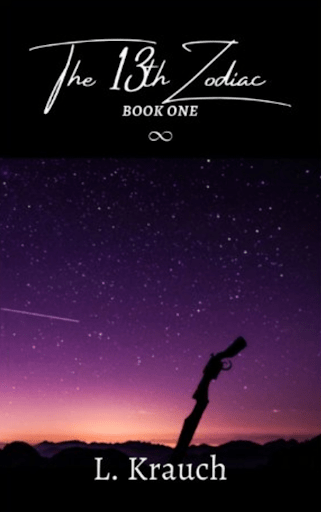
3.The 13th Zodiacby L. Krauch
L. Krauch writes Epic “Final” Fantasy
The 13th Zodiac: Final fantasy with actual romance
Cover art by L. Krauch
The plant: The Mother Tree
The Mother Tree gave birth to mortal man, so to speak. A 1000 years before the events of Book One Mother Urth and Father Sky created man. This single moment caused Time to turn on Urth and forever change her into the Mother Tree.
Snippet:
The Titan of Fate let her bare feet rest against the thick roots. Her wings, one black and one white, folded behind her, the tips brushed the wood as she walked. She dismissed them with a flick of her wrist. Feathers rained down around her, disappearing into dust. Clouds twisted around the massive Mother Tree as it reached toward the sky, branches desperate to touch it. Within the Mother Tree, paths formed naturally.
A cloaked man trotted up to greet Fate. The Prophet Skylis was tall with short black hair. The markings of the kingdom of Aria—a phoenix clutching an apple—adorned his dark-brown cloak. He wore a dyed, blue linen tunic and simple slacks. Fate clutched the Spear of Stars in her hand, and together they approached a cave hidden within the boughs. “She’s here.” No emotion escaped her voice as Fate clutched a spear in her right hand. Holding the other to her chest, she took a deep breath to steady her nerves.
One thousand years had passed since she saw her ex-lover. She glanced at the Prophet and ran her hand through her black and white hair, parting the two colors directly down the middle. A year and a half passed since his daughter was born with the symbol of Eternity on her tiny shoulder. What Fate hadn’t expected was the Titan’s shattered soul to be reborn so soon. Fate knew deep down the girl was in danger, even with the Titan of Time trapped within.
“I can’t see anything. Are you certain?” Skylis ducked to peer into the cave. Twisted roots and overgrowth from the tree obstructed the way. The roots created a hollow opening under the tree, ready to suffocate those who would wander in. Rhythmic breathing came from within the cave. Then a laugh. He backed up, surprised by the sound.
“Yes, I’m certain.” Fate placed the spear behind her, between where her wings awaited her command. She stepped into the pitch black of the cave. Skylis followed. Darkness engulfed them as they continued deeper within. In the distance, a faint glow of light shone on a feminine form bound by twisted roots to the wall of the tree. A sharp female laugh echoed again.
“Fate, my love… you’ve finally come… to visit,” a voice spoke.
Universal buy link
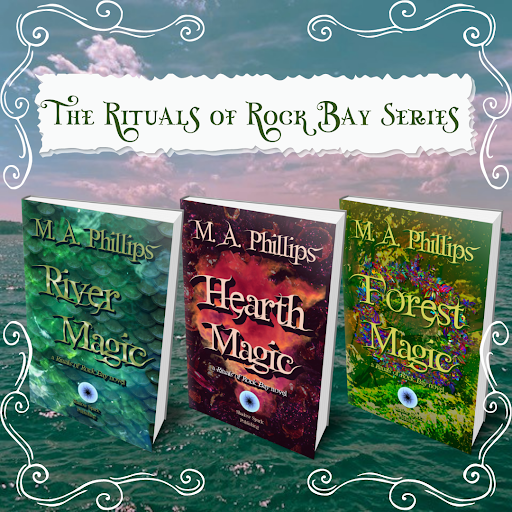
4.Forest Magicby M.A. Phillips
M.A. Phillips writes cozy Witch Lit featuring contemporary Pagan characters who practice realistic folk magic while also dating and holding down a 9-5 job.
The Rituals of Rock Bay trilogy: Follow Lacey and Cian, two modern Druids, as they navigate life, love, and the spirit world along the Saint Lawrence River.
The three covers for the series were designed by Jess and Chad Moon of Shadow Spark Publishing.
The plant: Rowan, or Mountain Ash

This is a baby rowan tree the author photographed in her backyard.
Rowan, or Mountain Ash, is a deciduous tree native to Europe and Asia, but introduced to the United States. Its white flowers develop into distinctive red-orange berries enjoyed by birds, cooks, and folk magicians. Associated with the Irish goddess Brigid, many witches and Druids work with this plant for its protective qualities.
Snippet from Forest Magic :
[Lacey] paused at the rowan tree on the edge of their property and pocketed some twigs waiting for her on the lawn with thanks.
“What’re those for?”
She patted her stomach. “Protection magic. With the baby coming, I need all the help I can get.” She skipped over the ditch and looked up.
Buy link
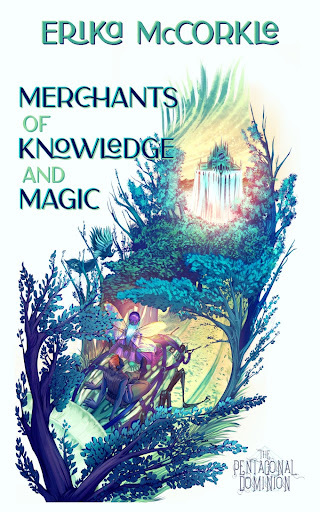
5.Merchants of Knowledge and Magicby Erika McCorkle
Erika McCorkle writes adult Epic Fantasy with a shit ton of worldbuilding crafted over the last two decades.
Series: The Pentagonal Dominion
Merchants of Knowledge and Magic: Merchant of knowledge Calinthe travels the world in search of secrets and to find a missing man.
Cover art by Bear Pettigrew, design by Jessica Moon.
The plant: Glowlight lotus
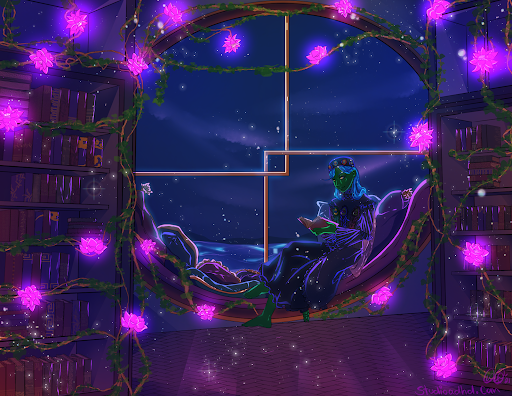
Picture of Calinthe, drawn by @DamiDraws_vt on Twitter.
The glowlight lotus is a climbing vine with pink lotus blossoms. The center contains a bulb full of bioluminescent material. Native to the tropics, but will grow in colder locations if tended to. Used as a light source by the people of the Pentagonal Dominion.
Glowlight lotus vines crawled across the tops of the shelves and along the railings, providing a splash of green and pink in addition to light with which to read by.
Buy from Amazon
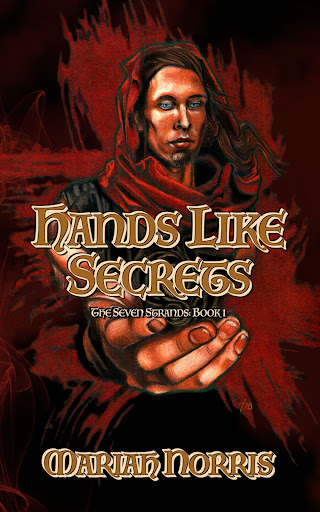
6.Hands Like Secretsby Mariah Norris
Mariah Norris writes fantasy with showy, complex magic and villains who always have a point.
Series: The Seven Strands
Hands Like Secrets: When Saeli confronts the notorious assassin Rafel as he’s about to kill her High Priestess, she’ll have to choose between everything she’s ever worked for…or helping her people’s sworn enemy end a hundred years of war.
Cover art was done by the author, and the layout was done by Jessica Moon.
The plant: Tanathe weed
Tanathe is a dark green, spiny plant that grows pretty much everywhere on Verre (thus why it’s considered a weed), though wild tanathe is smaller, spinier, and not as potent as the cultivated variety. The leaves, when crushed into a powder and taken orally, temporarily boost a majahel’s capacity to use qi (Verre’s magic system). Typically it’s used by front line soldiers to cover a retreat or by individuals needing extra strength to create extremely complex weaves (spells). The plant is addictive, however, and using too much at once can cause a person to “burn themselves out”, basically meaning they can no longer do magic. Crimson Cowl raiders rely on it more than their Silver Mantle counterparts and always carry a stash of powder for emergencies.
Wild or cultivated tanathe can also be rolled into sticks and smoked, which doesn’t confer any magical benefits but does produce a potent high. “Smoking” is a vice among Mantle teenagers and is grounds for expulsion from Aschamon. In this context, tanathe functions the same in their world as marijuana does in ours. In Hands Like Secrets, this is the only context in which my main character Saeli has ever encountered the drug.
In Book 2, in order to finally weave Rafel’s bridge form, she will have to use it for its intended purpose.
I reach the top of the stairwell as a bell rings somewhere in the house.
Curious, I pause at the railing to watch a servant bustle across the foyer to the front door. He escorts several laughing guys from Tammar Hall inside. With a shock I feel all the way down in my toenails, I spot Yan amongst them. It hadn’t occurred to me that he might show up; had Fien not known, or had they not wanted to mention it? He’s wearing nice slacks and a white top, and he’s taken some pains to tame his normally unruly hair.
He looks good tonight.
I fold my arms on the rail, missing him more than ever. Should I go down and try to talk to him? Would he ignore me here too, in front of all his friends?
He and the other guys abruptly bend their heads together.
I lean further over the railing and see several dark bundles change hands, and they all wear shifty expressions now. I narrow my eyes, Rafel and my earlier musings momentarily forgotten.
The group disappears down a side hallway. Deeply suspicious now, I hang back for several minutes, then tiptoe down the stairs after them.
The hallway ends at a paneled den with no windows. I peek in and stagger back, choking and coughing. Acrid clouds of smoke creep across the threshold, and even the tiny breath I’d taken has set my energy nodes to tingling.
Burning tanathe weed. That’s a smell you never forget. I was afraid that’s what had been in those little packages.
Buy from Amazon
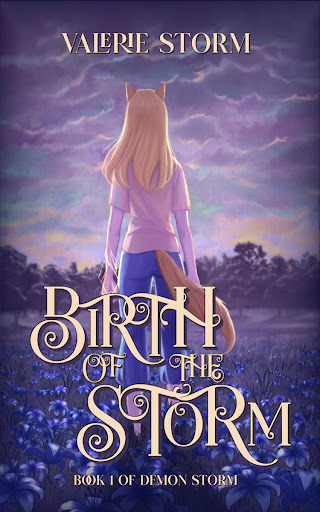
7.Birth of the Stormby Valerie Storm
Valerie Storm writes young adult fantasy, often with demons and always with DEATH AND TRAGEDY!
The book: Birth of the Storm (Demon Storm book 1): Is it possible for a creature like Kari to find happiness in a world that despises her?
Cover art by Ginka Jack. Cover design by Jessica Moon.
The plant: Demon Tree
It is a tree possessed by the soul of the original demon lord. It speaks to people it thinks it can manipulate (or gives impressions/feelings when it is too tired to speak) and has taken two souls by the start of the series.
Snippet:
A flicker of bizarre color brought her attention back down. The bark was no longer dark. Now it glowed with faint, white light, as if something lit it from the inside. Kari’s brows rose, then shot up as the color shifted again: ruby like fresh blood; sapphire, dark as the sea; violet, poisonous and lively.
They faded into each other gradually, until purple had turned to black, the color Kari had walked in on. She continued to stare, only moving closer when black had once again become white. The air warmed, making her arms pop with countless bumps.
She knew nothing substantial of Raziac Forest, save that demons were known to hide within its depths. Usually they were senseless, those unwilling or unable to make a home in the greater parts of Taris. They were content to hide here, occasionally disturbing the small human village nearby. Recently, she had learned of Zina’s existence as well.
This tree, though…what was it?
Another step put Kari within touching distance. She stared at the tree, searching the grooves within the bark for some sort of meaning.
She flinched as the music started again. It rang in her ears, sending her sprawling back. The shifting colors in the cracked trunk flashed, in sync with the lilting baritones. The ebony shine seemed even darker, lingering longer than the others.
The music came from the tree. She could see it in the invisible quiver of the leaves, trembling without even the slightest wind to move them.
That’s impossible.
“What are you?”
The tree continued to change, somehow humming its strange music. She couldn’t understand what this must mean.
I must touch it, she thought, a little feverish. If I feel it, maybe that will help me to understand.
Buy link

8.The Flyblown Crusadeby T R Peers
T R Peers: The books of the Curriculum are science-fantasy, with a cybernetic Operative thrown headlong into a magical world without warning.
The Flyblown Crusade: The third novel of the Thelenic Curriculum, in which Amanda Devereux may have killed a country, and Thalia Daran must slay her own prejudices.
Cover art by Sean Harrington. https://seanharringtonart.com/
The plant: Jakille Root
Jakille Root is an unusual plant that grows only in the Southern Blastings of Abelia, a profoundly blighted place in which the usual flow of Aether, the stuff of magic, is disrupted. When mixed into food or drink, it completely cuts the imbiber off from their magical abilities until metabolised.
Snippet:
“Do you know something interesting about the magic the High Wizards use to transfer a pregnancy from one woman to another, Magister Thalia?” she said, draining what little of her wine she hadn’t spilled on receiving the blow.
“I- I didn’t mean… what?” said Thalia in confusion, still trying to comprehend the impulsive stupidity of what she had done and wondering if she could blame the wine.
“It is particularly dangerous for a woman under the effects of the enchantment to attempt to use their own magic,” said the Queen. “So whilst serving as Royal Surrogates, my ladies-in-waiting eat food and drink wine laced with Jakille Root, picked in the Southern Blastings. Completely harmless, of course, but it does prevent one from harnessing one’s Spirit for a few hours.”
With mounting horror, Thalia tried to summon up her magic, at least to cleanse the alcohol from her system so she could think clearly. It would not respond- she could feel the power there, but every time she tried to harness it it seemed to slip away. “But… but you drank the same wine as I did…” she gasped. Tondarin laughed, and stood up, a little unsteadily.
“Oh, Thalia, you misunderstand my intent. This isn’t some sort of clever plot to murder you- if I’d wanted you dead, I could have had the thing done a hundred times by now.”
Buy from Amazon

9.The Surviving Skyby Kritika H Rao
Kritika H Rao writes Hindu philosophy inspired science fantasy, usually!
The Surviving Sky: A Hindu philosophy inspired epic science fantasy where a husband and wife duo try to save their floating plant city from crashing into jungle storms while they try to save their deteriorating marriage.
The plants: A wide variety of magical plants!
They show up as possibilities in a magical universe, where their consciousness is manipulated. My world has a lot of plants that are common to our own, such as jasmines and eucalyptus etc, but also a lot of fantastical plants, some of which heal people, some which reveal the truth, and some that predict when a storm is approaching. In THE SURVIVING SKY, cities are wholly made out of plants, and these plants are manipulated by magical architects to sustain the city and its people.
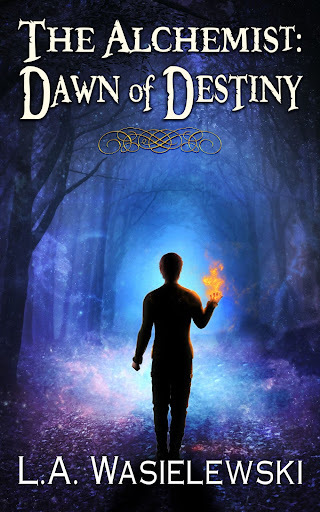
10.The Alchemist: Dawn of DestinyBy L.A. Wasielewski
L.A. Wasielewski writes adult high/dark fantasy filled with snark and sass.
The Alchemist Trilogy: All Ryris Bren wants to do is be a simple alchemist…but Lady Destiny has other plans for him.
Cover art by Gabriela–BRoseDesignz
The plant: Moat Pearls
They are found on trunks of fallen trees and forest debris, as silvery spheres. (Think: bubbles of mercury) They grow in dank forests, the shadier the climate, the better. The bubbles are very delicate, and filled with thousands of tiny spores which, when the bubble film is broken, get carried on the wind, resembling smoke. The spores are used as an ingredient in Paralysis Poisons. As for the name? No one knows…because they don’t grow in moats at all! It confounds alchemists everywhere!
Snippet:
She followed him through the underbrush until they came upon a large fallen tree trunk, covered in tiny silver spheres. They glistened in the mottled light of the forest, like little jewels on a crown.
“Those are called moat pearls. If you eat it, you can ‘blow smoke’ from your mouth.”
“Smoke?”
“Well…not really. They’re little spore pods. If you break it open on your tongue, you can blow them out and it looks like wisps of smoke.” He plucked one off the bark and placed it on his tongue. His voice was garbled as he tried not to bite down on the object. “Shee? Washh…” He moved it around, nestling it in the side of his cheek. His face bulged outward as he maneuvered the sphere carefully, mindful not to pierce the thin membrane containing the spores until he was ready to do so. He finally bit down, forming his lips into an ‘o’ before expelling the cloud of spores into the air. It indeed looked like silvery smoke. Kaia had to admit, it was mesmerizing. The alchemist tracked his head from side-to-side, blowing a stream of ‘smoke’ onto the currents, even making a ring. Kaia laughed at his antics. When he was out of spores, he spat the empty pod onto the forest floor, wiping his mouth on his sleeve. “Give it a try.”
“No way!”
“I promise it doesn’t taste bad. In fact…it tastes kind of like chocolate.”
Universal buy link

11.Blood, Fire, and Deathby Maria Blackrane
Maria Blackrane writes feminist grimdark with spice!
The book: Blood, Fire, and Death
The plant: Wolfsbliss
It has aphrodisiac properties. It’s native to Helvendias, originally found in the creepy forest called Tinsilor and named after the Wolf Goddess, who is more like a fertility nature spirit. It’s grown in the palace gardens and picked to use foe sex and fertility rites, and the “afterparty” orgies.
Snippets:
Yera picked Wolfsbliss from the gardens and dried the leaves into an incense. A plant often used in rites to induce lust and passion, although Thalia and Dillon needed no urging there.
***
Dozens of bodies were joined in the dance of primal lust, mouths open in climactic songs as old as time. The sounds of flutes and drums pulsed through the air, matching the rhythm of the movements and hearts beating with burning passion. The sweet incense reached Pensilea’s nose and made her heady. Eldurin caressed her bloodstained face. They joined hands and lowered themselves onto the cushions. This was how the Helvendians prayed, with lust and death.
Buy from Amazon
The post Plantasy appeared first on BEFOREWEGOBLOG.

